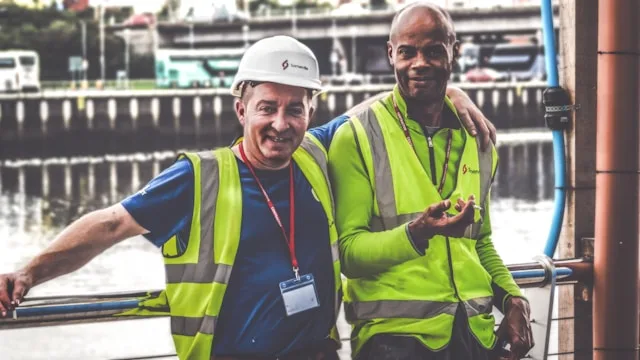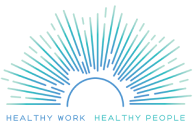FAQs
What is the Healthy Work Campaign?
The Healthy Work Campaign (HWC) is a public health campaign focused on raising awareness in the U.S. about the health impacts of work stress on working people. We provide expert guidance about the positive actions individuals and organizations can take to advance healthy work.
The Healthy Work Campaign is a project of the Center for Social Epidemiology (CSE), a 501c3 nonprofit.
What is your mission?
We aim to share knowledge, tools, and strategies with working people and other workplace stakeholders to reduce sources of stress at work, and improve working conditions and worker health. (Learn more here.)
What are your goals?
- Outreach to working people with labor unions/worker centers/OSH advocates
- Offer tailored, research-based guidance and solutions to public & private-sector organizations
- Develop strategic partnerships/a coalition to advocate for work stress prevention
What is ‘healthy work’?
‘Healthy work’ is a shorthand term for working conditions that minimize toxic work stressors that take a toll on the health and productivity of working people. Healthy work is respectful, just, more sustainable, and promotes health and well-being. (See Recommended work organization intervention studies on our Research page for more info.)
What are the benefits of ‘healthy work’?
‘Healthy work’ benefits individuals and organizations primarily by reducing harmful work stressors and improving health and well-being. (See What is Healthy Work? for more info.) A robust and growing literature provides scientific evidence that interventions to reduce work stressors can be beneficial for the health, well-being, and productivity of working people.
What is ‘unhealthy work’?
‘Unhealthy work’ is a shorthand term for work organized in a way which chronically exposes working people to work stressors. (See What is Healthy Work? for more info.)
What are work stressors?
Threatening or challenging experiences in our everyday lives, at work or at home, are called “stressors.” They provoke a natural, biological “fight or flight stress response” which increases our heart rate, respiration and releases cortisol and other stress hormones. While this ‘stress response’ is a ‘biopsychosocial’ experience involving an individual’s cognitive appraisal of a threat, the sources of stress at work (“work stressors”) are not just in your head—they are caused by the way work is organized and are amenable to change.
Why are work stressors ‘unhealthy’?
When we are chronically exposed to “stressors” at work, the effects of the short-term stress response accumulate and can lead to “mental distress” and physiological changes. Common work stressors include: excessive workloads, a lack of control (“job strain”), hostile or unsupportive relationships with supervisors or coworkers, effort-reward imbalance, work-family conflict, and more.
Over the long term, the cumulative impact of work stressors can lead to burnout and depression, as well as to physical changes in our bodies including permanent increases in blood pressure, inflammatory responses leading to cardiovascular changes, and even changes in our metabolism and autonomic nervous system. See here for more information.
What are the costs of ‘unhealthy work’ to individuals?
‘Unhealthy work’ costs individuals physically, psychologically, financially and socially. The everyday stress of long work hours, high demands, low job control, job insecurity, a lack of fairness or work-family conflict, can pose a real threat to health, well-being and even life span (shortening your life by up to 3 years), increasing your risk for burnout, depression, high blood pressure and even heart disease. The costs of these health problems related to work stress are being passed on to individuals in terms of higher healthcare premiums and deductibles, making access to healthcare in the U.S. more out of reach than ever.
See Stats & Infographics for more info.
What are the costs of ‘unhealthy work’ to organizations?
‘Unhealthy work’ costs organizations financially in several ways.
When workers experience work-related psychosocial stressors, they also report poorer physical and mental health, are less engaged, and are more likely to come to work sick and work less effectively (presenteeism), or they may stay home and take sick leave (absenteeism). By some conservative estimates, the healthcare costs of work stressors are 5-8% of annual U.S. healthcare costs (totaling $180 billion). (Goh et al, Management Science, February 2016)
But unhealthy work costs organizations more than just increased healthcare premiums. The added indirect costs to companies – which include the costs of increased absenteeism/sick leave, disability management, diminished productivity at work (presenteeism), and employee turnover– are estimated to be in the hundreds of billions of dollars. (Jauregui and Schnall. Unhealthy Work: Causes, Consequences, Cures, 2009)
See the Business Case for more info.
What are the top statistics I should know about ‘unhealthy work’?
- 77% of workers, having reported experiencing work-related stress in the last month, 57% indicated experiencing negative impacts because of it. (APA, 2023)
- 3 out of 5 (64%) Americans say that work is a significant source of stress. (APA, 2023)
- Those working 11+ hours per day are 2-3 times more likely to experience depression. (PO, 2012)
- Those with high levels of work stressors (job strain, effort-reward imbalance) are twice as likely to think about committing suicide than those with no or limited amounts of work stress. (JPR, 2016)
- 10-20% of all cardiovascular disease (CVD) in working age populations is related to the way we work. (IJOMEH, 2015)
- More than 120,000 deathsf per year are associated with how U.S. companies manage workers. (MS, 2016)
Where can I read more statistics about unhealthy work?
Check out our Stats & Infographics page.
What research has informed your claims?
The Healthy Work Campaign is committed to sharing all of our references and foundational research publications, acknowledging the large, global community of researchers and organizations who have informed our education campaign and related resources. We strive to give credit where credit is due, as well as reassure you of the substance and validity of this campaign. Please visit our Research page for our references and other essential info.
Who started this campaign?
The Center for Social Epidemiology (CSE), a Los Angeles-based non-profit organization founded in 1988, initiated the HWC in 2018 to expand the public health mission of the CSE and other organizations dedicated to improving the quality of work in the U.S. Visit our Who We Are page to learn more.
The Center has a longstanding relationship with the Centers for Occupational and Environmental Health (COEH) at UC Irvine and UCLA, and is an active member of the NIOSH Total Worker Health® Affiliate Program, dedicated to protecting and promoting the health and well-being of working people.
Who are your partners?
See our growing list of Partners, which include: American College of Occupational and Environmental Medicine, Coalition of Labor Union Women, Envisia Learning, HealthyWorkplaces, National Council for Occupational Safety & Health, Occupational Health Clinical Center, Occupational Health Clinics for Ontario Workers, Inc, Ontario Workplace Health Coalition, Joe Robinson/Optimal Performance Strategies, PACES Connection, Southern California Education and Research Center, UCLA Labor Occupational Safety & Health Program, Workplace Bullying Institute, and WorkSafe.
Who is your audience?
Our audience includes all healthy work stakeholders—anyone who cares about the impact of work on the health and well-being of working individuals, organizations and society, including (but not limited to): individuals, organizations, labor organizations, occupational health and safety professionals, public health advocates, healthcare professionals, educators, and public policymakers.
How do I share my work story?
If you want to share a short account of your work-related experiences, anonymously or by name, we would be happy to hear from you. The Healthy Work Campaign is looking for your stories about work (healthy and unhealthy) to share on healthywork.org (and potentially in our multimedia content). Please contact us to learn more.
What are your public policy objectives?
Currently our public policy objectives are suggestions-based, focused on local initiatives and policies. Visit our Laws & Regulations section on our Resources for Workers & Unions page for more ideas on healthy work advocacy in and outside of the U.S.
What can I do to make a difference?
You can learn about healthy work, assess work stress (for individuals and organizations), join the movement, schedule a workshop, or share your story with us. Visit Solutions for Employers, Resources for Workers & Unions, or Support Our Campaign for more ideas.
What are the terms & conditions of using this website and materials?
You can find our Terms of Use agreement on our Terms & Conditions page. When you use our website, you agree to these terms.
What is the privacy policy for this website and materials?
You can find our privacy policy on our Privacy page. There, and generally speaking, we intend to reassure you of our utmost respect for your privacy.
Do you have a medical disclaimer?
Yes. The contents of this website, such as text, graphics, images, videos, tools, and other material contained on the website (“Content”), are for informational purposes only and do not constitute, nor should they be considered a substitution for, medical advice.
The Content is not intended to be a substitute for professional medical advice, diagnosis, or treatment. Always seek the advice of a physician or other qualified health provider with any questions you may have regarding a medical condition. Never disregard professional medical advice or delay in seeking it because of something you have read on this website. The Site and the Content are provided on an “as is” basis.” Reliance on any information provided by this website is solely at your own risk.
Do you have a shorter version of this page?
Yes. Please download and check out our HWC Quick FAQs.






